|
| |
Kanu  Links Links
ATVs and Their Impact on Canoeing Country
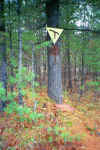
Background
ATV have arrived here about 20 years ago and have somewhat  matured
into affordable and reliable technology. They are 4-wheel drive vehicles, with large and
soft knobby tires so they grip well on varied terrain. They are both a plaything and a
work matured
into affordable and reliable technology. They are 4-wheel drive vehicles, with large and
soft knobby tires so they grip well on varied terrain. They are both a plaything and a
work horse: even though they have small engines, many still use 2-cycle engines, have no
effective pollution controls and release significantly more pollution per mile travelled
than your family car. Add to that the high torque that the engine/transmission generates,
and you will realize that this thing can chew up the ground really well. A skilled and
careful operator can minimize such damage. But on some types of terrain, such as hills and
in wet areas,
horse: even though they have small engines, many still use 2-cycle engines, have no
effective pollution controls and release significantly more pollution per mile travelled
than your family car. Add to that the high torque that the engine/transmission generates,
and you will realize that this thing can chew up the ground really well. A skilled and
careful operator can minimize such damage. But on some types of terrain, such as hills and
in wet areas,  damaging the soil and vegetation is unavoidable.
Even though there are careful riders, there are plenty of yahoos amongst the ATV community
that don't care. The industry is not helping either, with their commercials that advocate
boisterous freedom as the ATVs criss-cross the wilderness. Last not least, where one
vehicle may have nearly no impact, repeated travel over the same spot will start the
damage. damaging the soil and vegetation is unavoidable.
Even though there are careful riders, there are plenty of yahoos amongst the ATV community
that don't care. The industry is not helping either, with their commercials that advocate
boisterous freedom as the ATVs criss-cross the wilderness. Last not least, where one
vehicle may have nearly no impact, repeated travel over the same spot will start the
damage.
|
Here's what I have witnessed in the fall of 2000, by walking the 1 km portage
from Cox to Triangle Lake. This area is located in the Kawarthas, an
area which is about 2 hours drive NE from Toronto and has recently received protection
from Ontario's Living Legacy Land Use Strategy, possibly to become a Provincial Park. The
good folks from the MNR and the Kawartha advisory board will set the strategy on the use
of this park in the next months. They will have to decide how they want to curb the
advancing destruction wrought by these machines. The intensive use of ATVs in the area is
relatively new, and the damage has just started and unless ATV
use there is stopped, the damage to the environment will deepen and multiply.
Originally, the two lakes were connected by a single portage trail 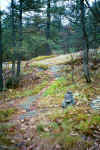 ,
no wider than 20 to 50 cm on the ground and bushes cropped back by occasional trail
clearing to create an unobstructed path that would allow the passing of a 3 ft wide canoe.
The soil was typically undisturbed, and the canopy not broken. ,
no wider than 20 to 50 cm on the ground and bushes cropped back by occasional trail
clearing to create an unobstructed path that would allow the passing of a 3 ft wide canoe.
The soil was typically undisturbed, and the canopy not broken.
A snowmobile trail appeared as these machines became
popular (maybe in the late 60's) and left its imprint on the land: a 6 ft wide swath with
vegetation often clipped back on its width. Damage to the ground was rare, because the
machines run for most of the season on snow and ice. A typical sign of snow mobile use are
the scratch marks left on rock surfaces - unsightly but of little consequence to the
environment- and the garbage that some of these folks leave in the bush. (picture of
abandoned sled). Not wanting to create a stir, canoeist noticed and lived with it.
I have noticed the first signs of ATV use about 15 years ago, when the
single trail started to deteriorate on the uphill sections, with the tell-tale evidence of
tire tracks. In the last few years, many ATVs now use the area and
have changed it drastically. Here's how:
 | Trails multiply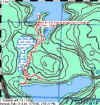 : the once single trail has grown several side trail, as shown on the
map clipping on the right. You will need to click on it to bring out the details. The
track was generated by walking all trails with a GPS and overlaying that track onto a topo
map. The old portage is one of the lines, starting where the text intersects the shoreline
of Cox Lake near the top of the image, and terminating on the shore of Triangle Lake at
the bottom. The ATV trail continues further along the red line to the west but was not
walked and thus is not shown. : the once single trail has grown several side trail, as shown on the
map clipping on the right. You will need to click on it to bring out the details. The
track was generated by walking all trails with a GPS and overlaying that track onto a topo
map. The old portage is one of the lines, starting where the text intersects the shoreline
of Cox Lake near the top of the image, and terminating on the shore of Triangle Lake at
the bottom. The ATV trail continues further along the red line to the west but was not
walked and thus is not shown.
There is an additional impact on portaging canoeists: he is confused as to where the real
portage is located and becomes frustrated as he sorts out the mess.
|
note about the map image: Extract of the
data set ORRVILLE_31E05 at 1:50,000
İHer Majesty the Queen in Right of Canada
Reproduced with the permission of Natural Resources Canada
 | Trails widen: 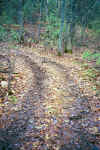 As the ATV is about 4 ft wide, the trail becomes As the ATV is about 4 ft wide, the trail becomes
 a double set of ruts, much wider that the
original path. In addition, as ATV drivers perceive obstacles, they go around them and
thus create a new tracks, each time chewing into the soil and vegetation. Consequently,
what used to be a single path is now a myriad of parallel trails. a double set of ruts, much wider that the
original path. In addition, as ATV drivers perceive obstacles, they go around them and
thus create a new tracks, each time chewing into the soil and vegetation. Consequently,
what used to be a single path is now a myriad of parallel trails.
|
 | 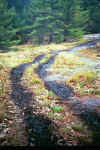 The surface of the path itself is
destroyed and so is the adjacent soil and vegetation. Aside from the damage to
the environment, canoeists portaging a boat is now having trouble getting safe footing. The surface of the path itself is
destroyed and so is the adjacent soil and vegetation. Aside from the damage to
the environment, canoeists portaging a boat is now having trouble getting safe footing. 

|
 | As 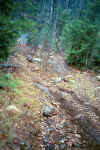 the ATVs frequent the portages on grades, the
once simple path starts to channel run-off water and the path turns into a creek
bed. This results in severe erosion which over time changes the land drastically.
For the canoeist, there is risk of injury from falls when the heavy gear is carried across
such portages. the ATVs frequent the portages on grades, the
once simple path starts to channel run-off water and the path turns into a creek
bed. This results in severe erosion which over time changes the land drastically.
For the canoeist, there is risk of injury from falls when the heavy gear is carried across
such portages.
|
 | The ATV folks destroy the nature as they try to rectify problems. the nature as they try to rectify problems.
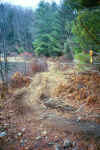 There are attempts at smoothening out a rocky
uphill section with concrete. There are attempts at smoothening out a rocky
uphill section with concrete.
At the shore of Triangle Lake, leading west and then up the hill, in order to facilitate
the new trail, vegetation was eradicated and large rocks were moved. Did these folks get a
work permit from the MNR? Even if they applied, I doubt that anyone charged to be the
steward of this land would sanction such a travesty.
|
 |  Some ATV folks consider Some ATV folks consider it their right to establish a camp in the woods, and thus bring
destruction of nature and heavy-duty garbage. it their right to establish a camp in the woods, and thus bring
destruction of nature and heavy-duty garbage.
|
 | 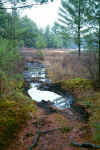  Wetlands suffer. Take a look and see how
the shore of Cox Lake is chewed up by ATV tracks. I'd think even ATV users bemoan this.
How come no one has laid charges yet - if this was private land, the owner would be
furious! Why does the ATV community not put a stop to such abuse? Wetlands suffer. Take a look and see how
the shore of Cox Lake is chewed up by ATV tracks. I'd think even ATV users bemoan this.
How come no one has laid charges yet - if this was private land, the owner would be
furious! Why does the ATV community not put a stop to such abuse?


|
You have seen the damage that ATVs will do, so think. We all value nature,
that's why we are out there in the first place.Something
has to change:
- ATV users need to rethink the unrestricted use of the machines.
- The ATV organizations have to establish an ethic that will preserve the
woods rather than destroy them.
- The ATV industry has to be pressured to manufacture less damaging machines.
- The MNR, as the steward of our lands, has to recognize the threat and must establish
tools that allows them to regulate the use of ATVs on crownland.
( Is there light at the end of the
tunnel: the Draft Recommendation of August 2001 prohibit the use of ATVs for recreational
purposes in this area! See here for info on the draft
recommendations and canoist's response) Is there light at the end of the
tunnel: the Draft Recommendation of August 2001 prohibit the use of ATVs for recreational
purposes in this area! See here for info on the draft
recommendations and canoist's response)
- Parks management will have to protect their land from ATV damage.
- And the soft-shoed public - naturalists, skiers, hikers and canoeists - must
speak up and stop this rape of the land.
If you are curious and would like to read more, here
are the links to some of the players:
 | ATV Ontario, a roof organization for ATV
users |
 | MNR (Ontario's Ministry of Natural
Resources), meant to enforce sustainable use of our public lands |
 | MOE (Ontario's Ministry of the
Environment), responsible for stopping pollution |
 | Some ATV Manufacturers
|
 | FON (Federation of Ontario
Naturalists), active to protect nature, such as forests and wetlands |
 | CPAWS (Canadian Parks and Wilderness Society,
with its Ontario chapter called the Wildlands League), dedicated to stop destructive use
of wetlands, forests and our special ecosystems |
 | WCA (Wilderness Canoe Association), a paddling club that aims to preserve
the wilderness experience |
|
PS: to see the damage that is done by ATV's to cross country ski trails,
look at the observations
made in the Sudbury area.
Back to Erhard's Canoe Pages
|
 ,
no wider than 20 to 50 cm on the ground and bushes cropped back by occasional trail
clearing to create an unobstructed path that would allow the passing of a 3 ft wide canoe.
The soil was typically undisturbed, and the canopy not broken.
,
no wider than 20 to 50 cm on the ground and bushes cropped back by occasional trail
clearing to create an unobstructed path that would allow the passing of a 3 ft wide canoe.
The soil was typically undisturbed, and the canopy not broken.

 Is there light at the end of the
tunnel: the Draft Recommendation of August 2001 prohibit the use of ATVs for recreational
purposes in this area! See here for info on the draft
recommendations and canoist's response)
Is there light at the end of the
tunnel: the Draft Recommendation of August 2001 prohibit the use of ATVs for recreational
purposes in this area! See here for info on the draft
recommendations and canoist's response)
















